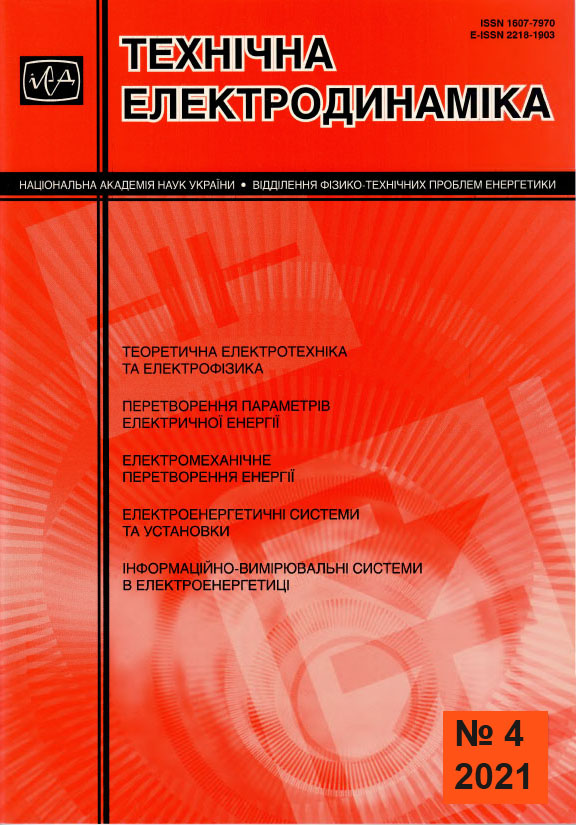Abstract
Theoretical researches of efficiency of electric energy transfer in the wireless charger of inductive type with serial resonance in circles of transmitting and receiving coils are carried out. It is shown that this efficiency depends on the parameter (the product of the magnetic coupling coefficient and the Q- factor of the coils) and the ratio of the active resistances of the battery and the coil. It is shown that there is an optimal value of this ratio, at which the efficiency of the device is maximum (when ) and its value increases monotonically with increasing parameter . Moreover, to achieve an efficiency greater than 0.8, it is necessary to have a system of coils with a value of 10. The graphical dependences that determine the value of this efficiency as a function of these two parameters and set the allowable interval for changing the resistance ratio in terms of high energy efficiency. Numerical calculation of the high-frequency magnetic field (with an operating frequency of 100 kHz) generated by the coils was performed, in two cases - in the absence of shielding and in the presence of aluminum electromagnetic screens and showed high efficiency of such screens. The peculiarity of the calculation is that to determine the values of complex currents in both coils, which depend on the mode of operation of the whole device, use their preliminary calculation based on the created Simulink-model of the device. References 14, figures 5, table 2.
References
Trivino-Cabrera A., Gonzalez-Gonzalez J., Aguado J. Wireless Power Transfer for Electric Vehicles: Foundations and Design Approach. Springer, 2020. 175 p. DOI: https://doi.org/10.1007/978-3-030-26706-3
Song M., Belov P., Kapitanova P. Wireless Power transfer inspired by the modern trends in electromagnetics. Applied Physics Reviews. 2017. No 4. Pp. 0211102(1-19). DOI: https://doi.org/10.1063/1.4981396
Patil D., McDonough M.K., Miller J.M., Fahimi B., Balsara P.T. Wireless power transfer for vehicular applications: overview and challenges. IEEE Transactions jn Transportation Electrification. 2017. No 4. Pp 3–37. DOI: https://doi.org/10.1109/TTE.2017.2780627
Kurs A., Karalis A., Moffat R. Wireless Power Transfer via Strongly Coupled Magnetic Resonances. Science Ex-press. 2007. Vol. 317. No 5834. Pp. 83-86. DOI: https:dooi.org/10.1126/science.1143254
Frivaldski M., Spanik P., Drgona P., Jaros V., Piri M. Analisis of Wireless Power System Efficiency in Dependecy on Configuration of Resonant Tank. Wireless Power Transfer - Fundamentals and Technologies, 2016. Pp.27-48. DOI: https://doi.org/10.5772/62998.
Kurkova O.P, Efimov V.V. Numerical computer modeling and optimization of circuit solutions for contactless chargers for electric drive vehicles. Sistemy upravleniia, svizi i bezopasnosti. 2019. No 3. Pp. 64-88. (Rus). DOI: https://doi.org/10.24411/2410-9916-2019-10305
Ahmad A., Saad Alam M.S., Chalan R.C. A Comprehensive Review of Wireless Charging Technologies for Electri-cal Vehicles. IEEE Transactions On Transportation Electrification. 2017. Vol. 4. No 1. Pp. 38-63. DOI: https://doi.org/10.1109/TTE.2017.2771619.
Choi S.Y., Jeong S.Y., Gu B.W., Lim G.C., Rim C.T. Ultraslim S-Type Power Supply Rails for Roadway – Powered Electric Vehicles. IEEE Transactions on Power Electron. 2015. Vol. 30. No 11. Pp.6456-6468. DOI: https://doi.org/10.1109/TPEL.2015.2444894
Bojarski M., Asa E., Colak K., Czarkowski D. A 25 kW industrial prototype wireless electric vehicle charger. IEEE Applied Power Electronics Conference and Exposition – APEC2016. Long Beach, CA, USA, March 20-24, 2016. Pp. 1756-1961. DOI: https://doi.org/10.1109/APEC.2016.7468105
Sato F., Morita J., Takura T., Sato T., Matsuki H. Research on Highly Efficient Contactless Power Station Systems using Meander Coil for Moving Electric Vehicle Model. Journal of the Magnetics Society of Japan. 2012. Vol. 36. No 3. Pp.249-252. DOI: https://doi.org/10.3379/msjmag.1205R014
Shimohara N. Wireless power Transmission progress for electric vehicle in Japan. IEEE Conferences on Radio and Wireless Symposium (RWS formerly RAWCON). Austin, TX, USA, January 20-23, 2013. Pp. 109-111. DOI: https://doi.org/10.1109/RWS.2013.6486657.
Kamineni A., Covle G.A., Boys J.T. Analysis of Coplanar Intermediate Coil Structures in Inductive Power Transfer Systems. IEEE Transactions on Power Electronics. 2015. Vol. 30. No 11. Pp. 6141-6154. DOI: https://doi.org/10.1109/TPEL.2014.2378733.
Vatsava, Ahmad A., Saad Alam M.S., Chalan R.C. Efficiency enhancement of wireless charging for electric vehi-cles through reduction of coil misalignment. IEEE Transportation Electrification Conference (ITEC), Chicago, IL, USA, June 22-24, 2017. Pp. 21-26. DOI: https://doi.org/10.1109/ITEC.2017.7993241.
Kalantarov P.L., Zeitlin L.A. Calculation of inductances. Leningrad: Energoatomizdat. 1986. 458 p. (Rus)

This work is licensed under a Creative Commons Attribution-NonCommercial-NoDerivatives 4.0 International License.
Copyright (c) 2021 Array






